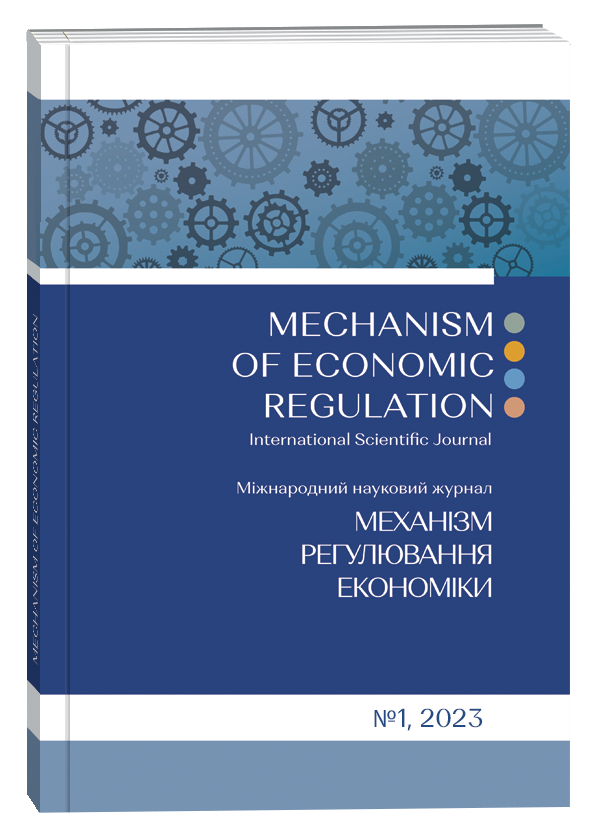THE ROLE OF THE EMISSIONS TRADING SCHEME IN PROMOTING RENEWABLE ENERGY IN THE EUROPEAN UNION
Abstract
cистема торгівлі квотами Європейського СоюзуThe study analysed data from 2005 to 2021 and found a downward trend in EU ETS allocations over time. The results indicate that the stationary installations sector, which includes power plants and other significant industrial emissions, received the most considerable allowance. The study also found a decrease in ETS allocations in all countries in 2020 due to the economic downturn caused by the pandemic. Furthermore, the paper examines the relationship between the EU ETS, EU GDP, and the share of renewable energy sources (RES). The results indicate a significant negative relationship between EU ETS and RES share, while EU GDP has a significant positive relationship with RES share. The findings suggest that while the EU ETS has begun to provide a price signal to incentivise companies to reduce their greenhouse gas emissions, it has yet to drive a shift towards renewable energy sources. The research also considered the impact of various external factors on the EU ETS. The paper highlights that the oversupply of emission allowances has been a persistent issue for the system since its inception. This oversupply resulted in a price that needed to be higher to incentivise a significant reduction in greenhouse gas emissions. The study found that unambitious overall targets, the economic crisis of 2008, and the influx of international loans were the main reasons for the insufficient price signal. The paper also examines the current state of the EU ETS Market Stability Reserve (MSR), which was created to address the problem of oversupply of allowances and the rising carbon price. The study found that while the MSR is absorbing excess allowances from the market and helping to cope with past oversupply, it is currently not suitable to cope with sudden shocks or future surpluses. In conclusion, the research indicates that the EU ETS is progressing towards reducing greenhouse gas emissions and providing a price signal to incentivise companies to reduce their carbon footprint. However, more policy interventions may be needed to support the transition to a low-carbon economy. The findings highlight the need to establish more stringent emission reduction targets and create incentives for investment in renewable energy sources.
References
Carbon Market Watch. EU Carbon Market. URL: https://carbonmarketwatch.org/our-work/carbon-pricing/eu-carbon-market/
European Union Emissions Trading System (EU ETS) data from EUTL. URL: https://www.eea.europa.eu/data-and-maps/data/european-union-emissions-trading-scheme-17 (Дата звернення 10.02.2023).
European Union. The EU Emissions Trading System (EU ETS). URL: https://ec.europa.eu/clima/policies/ets_en (Дата звернення 10.02.2023).
GDP and main components (output, expenditure and income). URL: https://ec.europa.eu/eurostat/databrowser/view/namq_10_gdp/default/table?lang=en (Дата звернення 10.02.2023).
Hoffmann V.H. EU ETS and Investment Decisions: The Case of the German Electricity Industry. European Management Journal. 2020. 25. 464-474.
Landis F., Heindl P. Renewable Energy Targets in the Context of the EU ETS: Whom do They Benefit Exactly? The Energy Journal. 2019.
Pietzcker, R.C., Osorio, S., & Rodrigues, R. (2021). Tightening EU ETS targets in line with the European Green Deal: Impacts on the decarbonisation of the EU power sector. Applied Energy. Vol. 40. № 6. Р. 129–169.
Rogge K.S., Hoffmann V.H. The impact of the EU ETS on the sectoral innovation system for power generation technologies - Findings for Germany. Energy Policy. 2010. 38. Р. 7639–7652.
Share of energy from renewable sources. URL: https://ec.europa.eu/eurostat/databrowser/view/NRG_IND_REN__custom_4959898/default/table?lang=en (Дата звернення 10.02.2023).
Yu M., He M., Liu F. Impact of Emissions Trading System on Renewable Energy Output. Procedia Computer Science. 2017. 122. 221-228.
Carbon Market Watch. (n.d.). EU Carbon Market. Available at: https://carbonmarketwatch.org/our-work/carbon-pricing/eu-carbon-market/
European Union Emissions Trading System (EU ETS) data from EUTL. Available at: https://www.eea.europa.eu/data-and-maps/data/european-union-emissions-trading-scheme-17
European Union. (2020). The EU Emissions Trading System (EU ETS). Available at: https://ec.europa.eu/clima/policies/ets_en
GDP and main components (output, exp. and income) Available at: https://ec.europa.eu/eurostat/databrowser/view/namq_10_gdp/default/table?lang=en.
Hoffmann, V.H. (2007). EU ETS and Investment Decisions:: The Case of the German Electricity Industry. European Management Journal, 25. Р. 464–474.
Landis, F., & Heindl, P. (2019). Renewable Energy Targets in the Context of the EU ETS: Whom do They Benefit Exactly? The Energy Journal.
Pietzcker, R.C., Osorio, S., & Rodrigues, R. (2021). Tightening EU ETS targets in line with the European Green Deal: Impacts on the decarbonization of the EU power sector. Applied Energy.
Rogge, K.S., & Hoffmann, V.H. (2010). The impact of the EU ETS on the sectoral innovation system for power generation technologies - Findings for Germany. Energy Policy, 38. Р. 7639–7652.
Share of energy from renewable sources. Available at: https://ec.europa.eu/eurostat/databrowser/view/NRG_IND_REN__custom_4959898/default/table?lang=en.
Yu, M., He, M., & Liu, F. (2017). Impact of Emissions Trading System on Renewable Energy Output. Procedia Computer Science, 122, 221-228.


